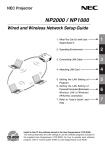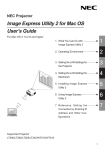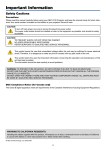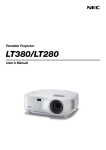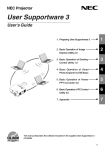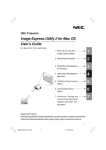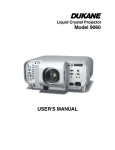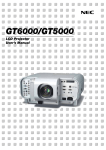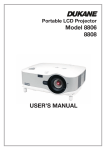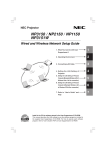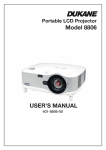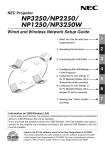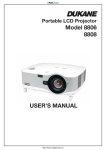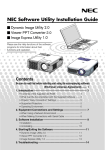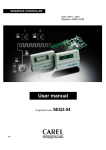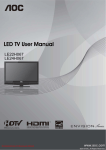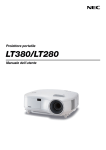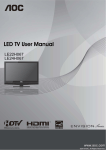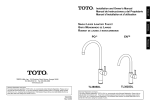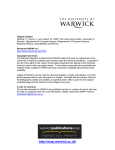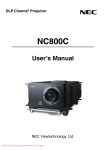Download - NEC Display Solutions Europe
Transcript
NEC Projector LT380/LT280 Wired and Wireless Network Setup Guide 1. What You Can Do with User Supportware 3 1 2. Operating Environment 2 3. Connecting LAN Cable 3 4. Attaching LAN Card 4 5. Setting the LAN Setting of Projector 6. Setting the LAN Setting of Personal Computer ([Example] Wireless LAN of Windows XP:Ad Hoc connection) 5 7. Refer to “User’s Guide” and Help 7 SELECT 3D REFOR MAUTO ADJUST SOURC E D TAN ON/S PC LAMP CARD STATUS POWER BY USB PC CARD COMPO NENT LAN IN S-VIDEO IN Cb/Pb VIDEO IN AUDIO Cr/Pr COMPU IN L/MONO AUDIO TER 3 IN COMPU TER R 1 IN AUDIO OUT MONITO COMPU TER R OUT 2 IN PC CONTR OL AC IN This manual describes the LAN settings to use the software programs included in the supplied User Supportware 3 CD-ROM. For how to operate each software program, refer to “User’s Guide” (PDF) on User Supportware 3 CD-ROM. 6 Introduction Thank you for purchasing the NEC projector LT380/LT280 (hereafter referred to as the “projector”). The projector is equipped with the following features so that you can give effective presentations. • LAN port (RJ-45), USB port (type A), PC card slot (TYPE II) supplied as standard • Viewer that displays images from a flash memory card*1 and USB memory*1 • Wireless LAN card supplied as an option*2 *1 The projector is not supplied with a flash memory card or USB memory. *2 For a list of countries where NEC’s optional wireless LAN card (NWL-100 series) is available, refer to the Service Page for NEC Projectors (http://www.nec-pj.com). The projector is also supplied with User Supportware 3 CD-ROM in which five programs of software are stored for effective use of these features. The software stored on this CD-ROM are as follows. Each program runs on Windows XP and Windows 2000. • • • • • Image Express Utility 2.0 Desktop Control Utility 1.0 Ulead Photo Explorer 8.0 SE Basic Viewer PPT Converter 3.0 PC Control Utility 3.0 This document explains how to configure the LAN settings to use the above software programs. For details of operations, refer to “User Supportware 3 User’s Guide” on User Supportware 3 CD-ROM and help function of the software. For the network settings on the personal computer, refer to the User’s Manual for the personal computer or the peripheral equipment for the network. Use a wireless LAN card conforming to the Wi-Fi standard for your personal computer. NOTES (1) The contents of this guide may not be reprinted in part or whole without permission. (2) The contents of this guide are subject to change without notice. (3) Great care has been taken in the preparation of this guide; however, should you notice any questionable points, errors or omissions, please contact us. (4) Notwithstanding article (3), NEC will not be responsible for any claims on loss of profit or other matters deemed to result from using the Projector. (5) Guides with incorrect collating or missing pages will be replaced. Cautions on Usage Cautions on Usage • • • • • A wireless LAN card is not meant for use with facilities or equipment involving the safeguard of human life, such as medical equipment, nuclear facilities or equipment, aeronautical or space equipment, transportation facilities or equipment, etc., or with facilities or equipment requiring high levels of reliability. Do not use the card in such cases. Do not use a wireless LAN card near cardiac pacemakers. Do not use a wireless LAN card near medical equipment. Doing so may cause electromagnetic interference with the medical equipment, possible leading to death. Do not disassemble or modify a wireless LAN card in any way. Doing so could lead to fire or electric shock. Do not use a wireless LAN card in wet or moist places, such as in bathrooms or near humidifiers. Doing so could lead to fire, electric shock or malfunctions. To prevent damage due to static electricity, eliminate any static electricity from your body before touching a wireless LAN card. • Static electricity from the human body may damage a wireless LAN card. Before touching the card, touch an aluminum window frame, a door knob, or some other metal object around you to eliminate the static electricity. The radio waves used by a wireless LAN card pass through the wood or glass used in normal homes (but not through window panes with built-in metallic mesh). The radio waves do not pass through iron reinforcing bars, metal or concrete, so a wireless LAN card cannot be used for communicating through walls or floors made with these materials. 1 Contents Contents Introduction ................................................................................ Inside cover Cautions on Usage ........................................................................................1 Contents .........................................................................................................2 1. What You Can Do with User Supportware 3 ........................................... 3 1-1. Image Express Utility 2.0 ...................................................................................... 3 1-2. Desktop Control Utility 1.0 .................................................................................... 5 1-3. Ulead Photo Explorer 8.0 SE Basic ...................................................................... 6 1-4. Viewer PPT Converter 3.0 .................................................................................... 7 1-5. PC Control Utility 3.0 ............................................................................................ 7 2. Operating Environment ............................................................................8 2-1. Supported Projector .............................................................................................. 8 2-2. Operating Environment ......................................................................................... 9 3. Connecting LAN Cable ...........................................................................10 4. Attaching Wireless LAN Card ................................................................ 11 5. Setting the LAN Setting of Projector ....................................................13 5-1. Displaying On-Screen Menu (LAN Mode) .......................................................... 13 5-2. Wireless LAN ...................................................................................................... 15 5-3. Wired LAN ........................................................................................................... 24 6. Setting the LAN Setting of Personal Computer ([Example] Wireless LAN of Windows XP: Ad Hoc connection) ........26 7. Refer to “User’s Guide” and Help .........................................................31 7-1. Displaying “User’s Guide” (PDF) .......................................................................... 31 7-2. Using Help ............................................................................................................ 33 2 1. What You Can Do with User Supportware 3 1. What You Can Do with User Supportware 3 1-1. Image Express Utility 2.0 Image Express Utility 2.0 is a software tool used to send the screen of your personal computer to the projector via a network, without the signal cables. ● High-speed, high-quality image transmissions based on NEC’s original compression algorithm SELECT 3D REFORM AUTO ADJUST SOURCE ON/STA PC LAMP CARD STATUS POWER ND BY PC USB CARD COMPONEN LAN T IN S-VIDEO IN VIDEO Cb/Pb IN AUDIO Cr/Pr IN COMPUTER L/MONOAUDIO 3 IN COMPUTER R 1 IN AUDIO OUT COMPUTER MONITOR OUT 2 IN PC CONTROL AC IN ● Simultaneous projection by multiple projectors Images can be sent from a personal computer to not only one projector but also to two or more projectors at the same time. SELECT 3D REFORM AUTO ADJUST SOURCE ON/STAN PC LAMP CARD STATUS POWER D BY PC USB CARD COMPONENT LAN IN S-VIDEO IN VIDEO Cb/Pb IN AUDIO Cr/Pr IN COMPUTER L/MONOAUDIO 3 IN COMPUTER R 1 IN AUDIO OUT COMPUTER MONITOR OUT 2 IN PC CONTROL AC IN SELECT 3D REFORM AUTO ADJUST SOURCE ON/STAN PC LAMP CARD STATUS POWER D BY PC USB CARD COMPONENT LAN IN S-VIDEO IN VIDEO Cb/Pb IN AUDIO Cr/Pr IN COMPUTER L/MONOAUDIO 3 IN COMPUTER R 1 IN AUDIO OUT COMPUTER MONITOR OUT 2 IN PC CONTROL AC IN ● ”Easy Connection” function for connecting wireless LAN By using “Easy Connection” function*1, the complicated setting of wireless LAN can be simplified. *1 This function can be used when Windows XP is used as the OS and when you have a “Computer Administrator” privilege. The communication mode is set to “802.11 Ad Hoc”. The “Easy Connection” function cannot be used with Windows 2000. 3 1 What You Can Do with User Supportware 3 NEC’s original compression algorithm allows high-quality images to be sent over the network at high speed, from your personal computer to the projector. 1. What You Can Do with User Supportware 3 ● Projected images can be transferred and saved to personal computers. When “Meeting Mode” is used, projected images can be sent to the personal computers of all the participants (attendants) of a “Meeting”. The received images can be saved to your personal computer with a memo (text data) attached. Attendant SELECT 3D REFORM AUTO ADJUST SOURCE ON/STAN D PC LAMP CARD STATUS POWER BY USB PC CARD COMPONENT LAN IN S-VIDEO IN Cb/Pb VIDEO IN AUDIO Cr/Pr COMPUTER IN L/MONO AUDIO 3 IN COMPUTER R 1 IN AUDIO OUT COMPUTER MONITOR OUT 2 IN PC CONTROL AC Attendant IN Presenter Attendant ● 1-click switching of presenter When switching to another presenter during the conference, the participants (attendants) can simply click a button to switch over to the new presenter. ● Central management of the projecting personal computer Using the Training Mode allows you to use a single personal computer (Manager) to manage which personal computer (Attendant) projects. Possible operation includes switching projecting personal computers to project from, as well as temporarily terminating communication with the projector. Mr. D, please start your presentation. Manager SELECT 3D REFORM AUTO ADJUST SOURCE ON/STAND PC LAMP CARD STATUS POWER BY PC USB CARD COMPONENT LAN IN S-VIDEO IN VIDEO Cb/Pb IN AUDIO Cr/Pr IN COMPUTER L/MONOAUDIO 3 IN COMPUTER R 1 IN AUDIO OUT COMPUTER MONITOR OUT 2 IN PC CONTROL AC Attendant A Attendant B IN Attendant D (presenter) Attendant C Note The Training Mode is not installed via the “Typical” installation option when Image Express Utility 2.0 is installed. To use Training Mode, select “Extension” installation option on the install selection screen that is displayed while Image Express Utility 2.0 installation is in progress, and select “Training Mode (Attendant)” or “Training Mode (Manager)”. 4 1. What You Can Do with User Supportware 3 1-2. Desktop Control Utility 1.0 Desktop Control Utility 1.0 is software that operates the desktop screen of a personal computer at a remote location from the projector by using a network. ● A commercially available USB mouse is connected to the projector to operate the personal computer. Conference room SELECT 3D REFORM AUTO ADJUST SOURCE ON/STAN PC LAMP CARD STATUS POWER D BY PC USB CARD COMPONENT LAN IN S-VIDEO IN VIDEO Cb/Pb IN AUDIO Cr/Pr IN COMPUTER L/MONOAUDIO 3 IN COMPUTER R 1 IN AUDIO OUT COMPUTER MONITOR OUT 2 IN PC CONTROL AC IN Office Important • You can use the Desktop Control Utility 1.0 to operate a personal computer located in a separate room from the projector over a network. Therefore, care must be exercised to prevent any third party from viewing the screen of your personal computer (important documents), copying files, or turning off the power. NEC assumes no liability for any loss or damages arising from information leak or system failure while you are using Desktop Control Utility 1.0. • In the Windows operating system, click [Control Panel] → [Performance and Maintenance] → [Power Options] → [System Standby] → [Never]. This will disconnect LAN connection when the personal computer goes in the standby mode while the Desktop Control Utility 1.0 is being used. • The screen saver function is off while Desktop Control Utility 1.0 is running. 5 1 What You Can Do with User Supportware 3 ● Suppose, for example, a PowerPoint file to be presented in a conference is saved to a personal computer in your office. If this personal computer is connected to the projector in the conference room with LAN when the conference is held, the desktop screen of the personal computer in your office (Windows XP/2000) can be projected and the PowerPoint file can be presented by operating the projector. In other words the personal computer does not need to be brought into the conference room. 1. What You Can Do with User Supportware 3 1-3. Ulead Photo Explorer 8.0 SE Basic Ulead Photo Explorer 8.0 SE Basic (hereafter referred to as “Ulead Photo Explorer 8.0”) is a multimedia image file management tool developed by Ulead Systems, Inc. This tool has functions to capture images from a digital camera or scanner and to process or edit images, as well as image file management functions. In addition, slideshows and screen savers can also be easily created. ● Ulead Photo Explorer 8.0 in the User Supportware 3 CD-ROM has functions that allow you to use the projector more conveniently, in addition to the functions that come with the software, for when an NEC projector is connected. Additional functions are listed below. For details of each function, refer to the help function of Ulead Photo Explorer 8.0. • Image transmission Sends images to the projector. • PowerPoint file conversion Converts a PowerPoint file into an image file. • Logo transfer Registers an image file as the logo data of the projector. • Capture Saves the screens of the personal computer as image files. • Slideshow start Sends the image of a slideshow to the projector and executes the slideshow on the projector. • Viewer output Converts a slideshow into an index file that can be played back by the viewer function of the projector and outputs the index file. • Connection destination selection Select the projector to connect. ● The personal computer and projector may be connected with wired LAN or wireless LAN. 6 1. What You Can Do with User Supportware 3 1-4. Viewer PPT Converter 3.0 Viewer PPT Converter 3.0 is software that converts files created with PowerPoint 95/97/ 2000/ 2002/2003 into an index file that can be displayed with the viewer function of the projector. ● When converting, specify a flash memory card or USB memory as the destination to which the index file is to be saved. Then you can easily make your presentation by simply inserting the flash memory card or USB memory into the projector (viewer function of the projector). 1-5. PC Control Utility 3.0 PC Control Utility 3.0 is software that allows you to operate the projector from the personal computer when the personal computer and the projector are connected with LAN (wired or wireless) or a serial cable. ● You can operate the projector as follows from your personal computer. For details of each function, refer to the help function of PC Control Utility 3.0. • • • • • Power on/off Input signal switching Muting (temporarily disabling audio/video) Freezing (locking the projected image) Logo image transmission 7 1 What You Can Do with User Supportware 3 ● If PowerPoint 2000/2002/2003 is installed in your personal computer, you can activate Viewer PPT Converter 3.0 from PowerPoint (PPT Converter add-in is automatically registered to PowerPoint). 2. Operating Environment 2. Operating Environment 2-1. Supported Projector User Supportware 3 supports the following NEC projector (as of October 2005) LT Series Reference 8 LT380/LT280 PC Control Utility 3.0 can be used with projectors other than the above projectors. For details, refer to the help function of PC Control Utility 3.0. 2. Operating Environment 2-2. Operating Environment The following is the operating environment for Image Express Utility 2.0. For the operating environment of other software, please refer to the help function of each software. Supported OS Windows 2000 Professional Windows XP Home Edition Windows XP Professional Windows XP Tablet PC Edition • Windows power-saving function is not supported. • The "Easy Connection" only supports the "Computer Administrator" authority of Windows XP. Supported hardware 2 IBM PC/AT compatible personal computers CD-ROM drive required for installation Sender personal computer Pentium MMX processor or higher required Pentium 800 MHz or higher recommended Recipient personal computer Pentium III 800 MHz or higher required Pentium III 1.2 GHz or higher recommended Windows XP Memory 128 MB or more required (192 MB or more recommended) • More memory may be necessary if other applications run at the same time. Windows 2000 64 MB or more required (128 MB or more recommended) • More memory may be necessary if other applications run at the same time. Network environment TCP/IP-compatible LAN or wireless LAN environment required Resolution 1024 dots × 768 lines recommended Screen Colors High Color (15 bits, 16 bits) True Color (24 bits, 32 bits) • 256 or fewer colors are not supported. Reference If the communication mode has been set to “802.11 Ad Hoc” for wireless LAN of the projector, IEEE802.11b specification (maximum transmission speed of 11 Mbps) is applied. 9 Operating Environment CPU 3. Connecting LAN Cable 3. Connecting LAN Cable Connect a LAN cable to the LAN port (RJ-45) of the projector when connecting the projector to wired LAN. After connecting LAN cable to the projector, set the required settings for the projector ( page 24). Server HUB, etc. LAN cable (commercially available) LAN USB LAN COMPUTER 3 IN PC CARD COMPONENT IN Y S-VIDEO IN Cb/Pb VIDEO IN AUDIO IN COMPUTER 1 IN COMPUTER 2 IN AUDIO OUT MONITOR OUT PC CONTROL Cr/Pr AUDIO IN L/MONO R AC IN 10 4. Attaching Wireless LAN Card 4. Attaching Wireless LAN Card Insert the wireless LAN card into the PC card slot on the rear panel of the projector. Important • The wireless LAN card must be inserted into the PC card slot in the correct direction. It cannot be inserted in the reverse direction. If the card is inserted in the reverse direction with excessive force applied, the pins in the projector and the PC card slot may break. Be sure to insert the wireless LAN card with its label facing up. • Before touching the LAN card, touch a metallic object (such as a door knob or aluminum window frame) to discharge the static electricity from your body. ■ Setting card in PC card slot 1 Press POWER ON/STAND BY button to set the projector to Stand-by mode, press the “O (off)” side of the main power switch of the projector. 4 the slot horizontally. 3D RE FO RM AU TO AD JU ST SO UR CE D N TA /S N O PC CA LA RD ST MP PO ATUS WER BY PC CA RD CO MP ON EN T IN Y S-VI DE O IN US B LA N VIDE Cb/Pb O IN AU DIO IN Cr/Pr L/M AUDI ON O O IN CO MP UT ER CO MP UT ER R AU DIO OU T 3 IN 1 IN MO NITO R OU T CO MP UT ER PC 2 IN CO NT RO L AC IN Note Do not apply any excessive force while inserting the card. 11 Attaching Wireless LAN Card 2 With the label on the wireless LAN card facing up, slowly insert the card into 4. Attaching Wireless LAN Card ■ Removing card from PC card slot 1 Press POWER ON/STAND BY button to set the projector to Stand-by mode, press the “O (off)” side of the main power switch of the projector. 2 Slowly press the PC card eject button. The PC card eject button will slightly come forward. 3 Slowly press the PC card eject button once again. The inserted card will slightly come forward. 3D RE FO RM AU TO AD JU ST SO UR CE D N TA /S N O PC CA LA RD ST MP PO ATUS WER BY PC CA RD CO MP ON EN T IN Y S-VI DE O IN US B LA VIDE Cb/Pb O IN N AU DIO IN Cr/Pr L/M AUDI ON O O IN CO MP UT ER CO MP UT ER R AU DIO OU T 3 IN 1 IN MO NITO R OU T CO MP UT ER PC CO NT 2 IN RO L AC IN 4 Slowly pull out the card. Reference PC Card Lock The supplied PC card lock prevents the wireless LAN card from being ejected use. Some PC cards cannot be used based on their size and shape. Use the supplled screw to fix the PC card lock. Wireless LAN card PC card lock PC US B CA RD CO MP S-V IDE O IN PC CA CO ON US RD MP EN T IN Y ON B EN T IN Y S-V IDE O IN C b/P VID b EO IN Cr/ Pr L/M AU ON DIO O IN C b/P VID b EO IN Cr/ Pr L/M AU ON DIO O IN R 12 5. Setting the LAN Setting of Projector 5. Setting the LAN Setting of Projector Reference For how to turn on/off the power to the projector and how to operate the buttons and remote control of the projector, refer to “User’s Manual” included in the User’s Manual CD-ROM. 5-1. Displaying On-Screen Menu (LAN Mode) Preparation: Turn on the power to the projector and project images to the screen. It is not necessary to select the signals. 1 Press the button. The on-screen menu will be displayed. 5 Setting the LAN Setting of Projector Highlight 2 Use the 3 Press the button to select the Setup submenu. button. The “Basic” tab will be highlighted. 13 5. Setting the LAN Setting of Projector 4 Press the button three times to highlight the “Installation” tab. 5 Press the SELECT button three times to highlight “LAN Mode”, and press the button. The “LAN Mode” screen will be displayed. • To make setting of wireless LAN Proceed to “5-2. Wireless LAN” ( next page). • To make setting of wired LAN Proceed to “5-3. Wired LAN” ( page 24). 14 5. Setting the LAN Setting of Projector 5-2. Wireless LAN When inserting the wireless LAN card into the PC card slot of the projector, configure the LAN settings in the “PC Card” page of “LAN Mode” selected from On-Screen Menu. ■ Flow of Setting Step 1 Display "PC Card" page of "LAN Mode". Step 2 Select "Profiles". Step 3 Enable or disable "DHCP". If "Disabled" (without check mark) If "Enabled" (with check mark) Step 4 Input "IP Address". If "Easy Connection" is selected Step 5 Input "Subnet Mask". Step 6 Input "Gateway". 5 Step 7 Input "DNS Configuration". Setting the LAN Setting of Projector Step 8 - 16 Setting of "Advanced". 8 Setting of "Network Type". 13 Setting of "WEP" 9 Select SSID in "Site Survey". 14 Select the number of bits of "WEP". 10 Input "SSID" (if necessary). 15 Select "Key Select". 11 Select "Mode" (if necessary). 16 Set "Key 1 to Key 4". 12 Select "Channel" (if necessary). Step 17 Finalize "Advanced". Step 18 Reconnect the network. Step 19 Finalize the setting. 15 5. Setting the LAN Setting of Projector ■ Setting Wireless LAN 1 Display the “PC Card” page of “LAN Mode”. Configure the setting of wireless LAN in the "PC Card” page of “LAN Mode” selected from On-Screen Menu. <1> In the “LAN Mode” setting window, if the “Built-in” tab is highlighted, press the button to highlight “PC Card”. The “PC Card” page will be displayed. • If “LAN Mode” is not displayed, refer to “5-1. Displaying On-Screen Menu (LAN Mode)” ( page 13). 2 Select “Profiles”. <1> Press the SELECT button once to highlight the “Profiles” field and press the <2> Use the SELECT / button to highlight “Profile 1”, and press the button. button. • “Profile 1” or “Profile 2” can be stored in the memory of the projector as the setting for LAN. • “Easy Connection” is a mode in which the personal computer that runs Image Express Utility 2.0 in the User Supportware 3 CD-ROM is easily connected to wireless LAN. Note that “Easy Connection” does not support software other than Image Express Utility 2.0. • When “Easy Connection” is selected, the IP address and subnet mask do not have to be set. To use “Easy Connection”, the OS of the personal computer must be Windows XP ([Computer Administrator] privilege). It cannot be used with Windows 2000. The communication mode is “802.11 Ad Hoc”. 16 5. Setting the LAN Setting of Projector 3 Set “DHCP”. Check this check box if the network to which the projector is to be connected automatically assigns the IP address via the DHCP server. <1> Press the SELECT button once to highlight the “DHCP” check box and press the button. A check will be given if there is no mark found in the box. • To clear the check box, press the button once again. button. Proceed • If “DHCP” is checked, move the highlight to “Advanced” and press the to step 9 ( page 19). Input “DNS Configuration” field as necessary. • If “DHCP” is not checked, input “IP Address”, “Subnet Mask”, “Gateway”, and “DNS Configuration” as necessary. After each item has been set, move the highlight to “Advanced” and press the button. Proceed to step 9 ( page 19). 4 Input “IP Address”. If “DHCP” is not checked, input the IP address assigned to the projector by the administrator of the network to which the projector is connected. <1> Press the SELECT button once to highlight the “IP Address” field and press the button. The software keyboard will be displayed. 5 button. <3> Repeat step <2> above to input the IP address. • Each button on the software keyboard has the following function. • “SP” .................. Inputs space. • “BS” .................. Deletes one character to the left of the character insertion position in the “IP Address” field. • “ ” “ ” ........... Moves the character insertion position in the “IP Address” field to the left or the right. • [OK] .................. Finalizes the input character and closes the software keyboard. • [Cancel] ............ Cancels the input character and closes the software keyboard. 17 Setting the LAN Setting of Projector <2> Use the SELECT button to select a number to input, and press the The characters will be input. 5. Setting the LAN Setting of Projector 5 Input “Subnet Mask”. If “DHCP” is not checked, input the subnet mask of the network to which the projector is connected. The method of inputting is the same as that of the “IP Address” field. 6 Input “Gateway”. If “DHCP” is not checked, input the default gateway of the network to which the projector is connected. The method of inputting is the same as that of the “IP Address” field. 7 Input “DNS Configuration”. Set the IP address of the DNS server of the network to which the projector is connected. The method of inputting is the same as that of the “IP Address” field. Example of setting 1 8 Select “Advanced”. Set “Network Type” and “WEP” (encryption) specific to wireless LAN. <1> Use the SELECT / button to highlight “Advanced” on the “Profile” page and press the button. The “Advanced” screen will be displayed. 18 5. Setting the LAN Setting of Projector 9 Select SSID from “Site Survey” (if necessary). A list of SSID that can be connected to wireless LAN in this place are displayed, and the SSID that are to be connected are selected from this list. When SSID is selected from the list, the “SSID” field, “Mode” field and “Channel” field will also be automatically set. <1> Press the SELECT button once to highlight “Site Survey” and press the Searching SSID will begin. When searching SSID is complete, a list of SSID is displayed. button. Icon ............ Access point ............ Personal computer (Ad Hoc) ........... WEP setting <2> Use the SELECT / button to highlight the SSID of the network to be connected. Press the button once to highlight [OK] and press the button. If the SSID to be connected is not on the list, press the EXIT button. 5 Note 10 Input or edit “SSID” (if necessary). SSID selected in “Site Survey” are automatically input. If the highlight is moved to the “SSID” field and the displayed and characters can be input or edited. The default setting of the projectors is “NECPJ”. button is pressed, a software keyboard is 19 Setting the LAN Setting of Projector To connect SSID for which WEP is set, the same setting must be made on the projector ( page 21). 5. Setting the LAN Setting of Projector 11 Select “Mode” (if necessary). The communication mode of the SSID selected in “Site Survey” are automatically selected. The settings can be changed by moving the highlight to the “Mode” field and pressing the button. • “Infrastructure” .............. This is selected if communication is performed with two or more devices connected by wired or wireless LAN via an access point. • “802.11 Ad Hoc” ............ This is selected to perform peer-to-peer communication between the projector and a personal computer by using only wireless LAN. Example of connection when “Mode” is “Infrastructure” Example of connection when “Mode” is “802.11 Ad Hoc” SELECT SELECT 3D 3D REFORM REFORM AUTO AUTO ADJUST ADJUST SOURCE SOURCE ON/STA ON/STA BY BY PC LAMP CARD STATUS POWER ND PC LAMP CARD STATUS POWER ND PC PC CARD COMPONENT CARD COMPONENT IN IN S-VIDEO S-VIDEO IN VIDEO IN Cb/Pb IN AUDIO Cr/Pr IN AUDIO Cr/Pr IN COMPUTER 3 IN COMPUTER R 1 IN AUDIO Cb/Pb L/MONOAUDIO 3 IN COMPUTER R VIDEO IN COMPUTER L/MONOAUDIO 1 IN AUDIO OUT OUT COMPUTER MONITOR OUT COMPUTER MONITOR OUT 2 IN PC 2 IN PC CONTROL AC CONTROL AC IN IN Access point Wired LAN Example of setting 2 12 Select “Channel” (if necessary). Select a channel for communication using wireless LAN. If neighboring channel numbers are used in one area, the speed of wireless LAN communication decelerates. To avoid such a situation, select discrete channel numbers. The setting upon shipment is "Automatic". 20 5. Setting the LAN Setting of Projector 13 Select “WEP” page (if necessary). Proceed to step 17 if WEP is not set. <1> Use the SELECT / button to select the “Network Type” tab, and press the button to highlight the “WEP” tab. The “WEP” page will be displayed. 14 Select “WEP”. Select whether WEP (encryption) is performed or not. To perform WEP (encryption), set an encryption key. • Disable ................... WEP (encryption) is not performed. There is a danger that the contents of communication are monitored. • 64 bit ...................... 64-bit data is used as an encryption key of WEP. • 128 bit .................... 128-bit data is used as an encryption key of WEP. • 152 bit .................... 152-bit data is used as an encryption key of WEP. 15 Select “Key Select” (only when WEP is selected). If “64 bit”, “128 bit”, or “152 bit” is selected from “WEP”, select which of the following encryption keys, “Key 1” to “Key 4”, is to be used. 21 Setting the LAN Setting of Projector Security is reinforced as the number of bits is increased. 5 5. Setting the LAN Setting of Projector 16 Input “Key 1” to “Key 4”. If “64 bit”, “128 bit”, or “152 bit” is selected from “WEP”, input an encryption key. Set the same encryption key as the access point and personal computer to be connected by the wireless LAN. Four types of keys can be input for WEP. Authentic Method 64 bit Alphanumeric Hexadecimal Character (ASCII) Number (HEX) 5 characters 10 characters 128 bit 13 characters 26 characters 152 bit 16 characters 32 characters <1> Use the SELECT / button to select an item for which the encryption key is to be input and press the button. The software keyboard will be displayed. <2> Use the SELECT button, move the highlight to a character, and press the button. <3> Repeat step <2> above to input the encryption key. The character will be input. • Each button on the software keyboard has the following function. • “ ” “ ” ................. Move the character insertion position in the encryption key field to the left or the right. • “MODE” ................. Selects uppercase, lowercase, or special characters. • “SP” ....................... Inputs space. • “BS” ....................... Deletes one character to the left of the character insertion position in the encryption key field. • [OK] ....................... Finalizes the input character and closes the software keyboard. • [Cancel] ................. Cancels the input character and closes the software keyboard. • “HEX” or “ASCII” .... Selects alphanumeric character input or hexadecimal number input. • When “HEX” is displayed, alphanumeric characters (ASCII) can be input. • To input hexadecimal numbers, move the highlight to “HEX” and button. “ASCII” will be displayed instead of press the “HEX”, and hexadecimal numbers can be input. • When hexadecimal numbers can be input, “0x” is automatically displayed at the beginning of the input field. 22 5. Setting the LAN Setting of Projector 17 Finalize “Advanced”. <1> Use the SELECT / button to highlight [OK] and press the The “PC card” page will be displayed again. button. 18 Reconnect the network. <1> Use the SELECT / button to highlight “Reconnect” and press the button. 19 Finalize the setting. <1> Use the SELECT / button to highlight [OK] and press the button. The contents of the setting will be stored in the memory of the projector. 5 Setting the LAN Setting of Projector 23 5. Setting the LAN Setting of Projector 5-3. Wired LAN When connecting a LAN cable to the LAN port of the projector, configure the LAN settings in the “Built-in” page of “LAN Mode” selected from On-Screen Menu. ■ Flow of setting Step 1 Display "Built-in" page of "LAN Mode". Step 2 Select "Profiles". Step 3 Enable or disable "DHCP". If "Disabled" (without check mark) If "Enabled" (with check mark) Step 4 Input "IP Address". Input "Subnet Mask". Input "Gateway". Step 5 Input "DNS Configuration". Step 6 Reconnect the network. Step 7 Finalize the setting. 24 5. Setting the LAN Setting of Projector ■ Setting Wired LAN 1 Display the “Built-in” page of “LAN Mode”. Configure the setting of wired LAN in the “Built-in” page of “LAN Mode” selected from On-Screen Menu. If “LAN Mode” is not displayed, refer to “5-1. Displaying On-Screen Menu (LAN Mode)” ( page 13). 2 Select “Profiles”. “Profile 1” or “Profile 2” can be stored in the memory of the projector as the setting of LAN. <1> Press the SELECT button once to highlight the “Profiles” field and press the button. <2> Use the SELECT / button to highlight “Profile 1” or “Profile 2”, and press the button. 3 Set “DHCP”. Follow the same procedure as in “5-2. Wireless LAN” ( page 17). 4 Input “IP Address”, “Subnet Mask”, and “Gateway”. Follow the same procedure as in “5-2. Wireless LAN” ( page 17,18). 5 Input “DNS Configuration”. Follow the same procedure as in “5-2. Wireless LAN” ( page 18). 5 6 Reconnect the network. 7 Finalize the setting. <1> Use the button to highlight [OK] and press the button. The setting will be stored in the memory of the projector. 25 Setting the LAN Setting of Projector <1> When all the above items have been input or set, use the SELECT / button to highlight button. “Reconnect” and press the 6. Setting the LAN Setting of Personal Computer 6. Setting the LAN Setting of Personal Computer ([Example] Wireless LAN of Windows XP: Ad Hoc connection) This section explains the procedure for Ad Hoc connection of wireless LAN between the personal computer and projector, by using the wireless network setting function with Windows XP Service Pack 2 (SP2). Preparation: • Install a commercially available wireless LAN card driver to your personal computer, and complete setup of the wireless LAN card. For how to install the driver, refer to the User’s Manual of the wireless LAN card. • Check the display of the Windows XP taskbar. If a network connection utility dedicated to a wireless LAN card is executed, terminate that utility. • Make the wireless LAN setting of the projector. For details, refer to “4. Attaching Wireless LAN Card” ( page 11) and “5. Setting the LAN Setting of Projector” ( page 13). Shown below is an example of the wireless LAN settings for the projector. [Example of settings for projector] Contents Settings IP Address 192.168.100.10 Subnet Mask 255.255.255.0 SSID NECPJ Mode 802.11 Ad hoc WEP 64 bit Key Select Key 1 Key 1 NECVT 1 Click Windows [Start] → [Control Panel]. The “Control Panel” window will be displayed. 2 Double-click the “Network Connections”. • If the “Control Panel” window displays categories (with a blue background), click [Network and Internet Connections], and then click [Network Connections]. The “Network Connections” window will be displayed. 26 6. Setting the LAN Setting of Personal Computer 3 Right-click the [Wireless Network Connection] icon and click [Property]. Right-click 3-2 Click A property window for wireless network connections will be displayed. 4 From the list of [This connection uses the following Items:], select (click) [Internet Protocol (TCP/IP)] and click [Properties]. Setting the LAN Setting of Personal Computer 3-1 6 4-1 Select 4-2 Click • The property window for wireless network connections will be displayed again. 27 6. Setting the LAN Setting of Personal Computer 5 Click [Use the following IP address:], and input [IP address]and[Subnet mask]. • If, for example, the [IP address] and [Subnet mask] of the projector are set as show in “Example of settings for projector” on page 26, set the personal computer as shown below. • Example of setting the IP address and subnet mask. Projector ( page 26) Personal computer(Screen Below) IP Address 192.168.100.10 192.168.100.20 Subnet Mask 255.255.255.0 255.255.255.0 5-1 Click 5-2 Input 6 Click [OK]. A property window for wireless network connections will be displayed. 7 Click the [Wireless Networks] tab. 8 Click [Use Windows to configure my wireless network settings], display the check mark ( ) and click [OK]. 7 Click 8-1 Click 8-2 28 Click 6. Setting the LAN Setting of Personal Computer 9 Right-click the [Wireless Network Connection] icon and click [View Available Wireless Networks]. Right-click 9-2 Click The “Wireless Network Connection” window is displayed. 10 From the list, select SSID of the projector to be connected and click [Connect]. 10-1 Click Setting the LAN Setting of Personal Computer 9-1 10-2 Click The “Wireless Network Connection” window is displayed. 6 29 6. Setting the LAN Setting of Personal Computer 11 Input WEP key to set up an encryption key and click [Connect]. • Input an encrypiton key of “WEP”. Enter “NECVT” in the Network key box, for example, if you have the WEP setting on the projector side configured with “64bit” and have “NECVT” input as Key 1. • The same encryption key should be input in the confirmation. 11-1 Input 11-2 Click The window above does not appear unless WEP key is not configured on the projector to be connected. Follow the steps below to change the encryption settings. For details, see the Windows Help file. (1)Click [Change advanced settings] from the screen in step 10 above. The “Wireless Network Connection Properties” window is displayed. (2)Click the [Wireless Network] tab. (3)Select SSID of the projector under [Preferred Networks] and click [Properties]. The “Properties” of the selected SSID is displayed. Configure the wireless network key under the [Association] tab according to those for the projector. This Completes the Ad Hoc connection of wireless LAN on the personal computer (Windows XP). Use each software program in User Supportware 3 to transmit the PC screen to the projector. 30 7. Refer to “User’s Guide” and Help 7. Refer to “User’s Guide” and Help Each software program in User Supportware 3 contains each help file that explains the functions and operation methods in detail. Also, “User’s Guide” (PDF) explains the basic operation procedure of each software program carefully. 7-1. Displaying “User’s Guide” (PDF) Important Refer to “User’s Guide” and Help • User Supportware 3 CD-ROM does not contain Acrobat Reader or Adobe Reader. If no PDF file can be opened from your personal computer, download Adobe Reader from the Adobe Systems Incorporated home page, and install it. 1 Turn on your personal computer to start Windows. 2 Insert User Supportware 3 CD-ROM in the CD-ROM drive. The menu will be displayed. 7 3 Click [Viewing User’s Guide]. [User’s Guide] will be displayed. For the following operations, browse User’s Guide according to Acrobat Reader or Adobe Reader operation method. 31 7. Refer to “User’s Guide” and Help Reference If the above menu is not displayed, follow these steps. 1. Click [Start] of Windows. 2. Click [Run...]. 3. In the [Open:] field, enter the CD-ROM drive name *1 (e.g., “Q:\”) followed by “SETUP.EXE” (e.g., “Q:\SETUP.EXE). *1 The CD-ROM drive name will vary depending on your personal computer’s configuration. 4. Click [OK]. The menu will be displayed. 32 7. Refer to “User’s Guide” and Help 7-2. Using Help The functions and operation of each software are described on the Help screen. This section introduces how to display and use the Help screen. Note • The following instructions use operations under Windows XP as an example. • Before displaying Help, install each software onto your personal computer from the User Supportware 3 CD-ROM. You cannot run the programs nor view Help directly from the CD-ROM. Refer to “User’s Guide” and Help ■ Displaying Helps other than Ulead Photo Explorer 8.0 Click in the following order. Start All Programs NEC Projector User Supportware Desktop Control Utility 1.0 Desktop Control Utility 1.0 Help Image Express Utility 2.0 Image Express Utility 2.0 Help PC Control Utility 3.0 PC Control Utility 3.0 Help Viewer PPT Converter 3.0 Viewer PPT Converter 3.0 Help Reference 7 You can also display the Help by starting each program and clicking the [Help] menu or [Help] icon of that program. 33 7. Refer to “User’s Guide” and Help ■ Displaying Ulead Photo Explorer 8.0 Help To display the Help of Ulead Photo Explorer 8.0, start the software and make your selection from the [Help] menu. 1 Click [All Programs] in the start menu → [Ulead Photo Explorer 8.0 SE Basic] → [Ulead Photo Explore 8.0 SE Basic], in that order. The Ulead Photo Explorer 8.0 will start. 2 From the Ulead Photo Explorer 8.0 menu bar, select [Help] → [Ulead Photo Explorer Help] or [NEC Projector User Supportware Help]. ■ Help Screen Layout [Hide] button Shows/hides the left pane. [Back] button Displays the previously displayed topic. [Forward] button Displays the previously displayed topic when using the [Back] button to step back through the topics. [Print] button Prints the displayed Help topic. [Contents] tab Displays the contents of Help. Select a topic to display contents in the right pane. [Index] tab Displays a list of keywords for Help. Select a keyword to display the associated topics. [Search] tab Searches through Help for the entered text. 34 Explanation displaying area Displays content for the topic selected in the left pane. MEMO 35 MEMO 36 • • • • • IBM and PC/AT are registered trademarks of International Business Machines Corporation. Microsoft, Windows, PowerPoint, MS, MS-DOS, and DirectX are registered trademarks or trademarks of Microsoft Corporation in the U.S. or other countries. Ulead Systems and Photo Explorer are registered trademarks of Ulead Systems, Inc. Adobe, Adobe Acrobat Reader, and Adobe Reader are registered trademarks or trademarks of Adobe Systems Incorporated in the U.S. or other countries. Other manufacturer names and product names in this document are registered trademarks or trademarks of the respective companies. ©NEC Viewtechnology, Ltd. 2005 Printed in Japan First edition October 2005 Reproduction, modification, and other uses are prohibited without the permission of NEC Viewtechnology, Ltd. LT380/LT280 Wired and Wireless Network Setup Guide NEC Projector User Supportware 3 ■ ■ ■ ■ ■ Printed on Recycled Paper Image Express Utility 2.0 Desktop Control Utility 1.0 Ulead Photo Explorer 8.0 SE Basic Viewer PPT Converter 3.0 PC Control Utility 3.0 7N8P6251








































